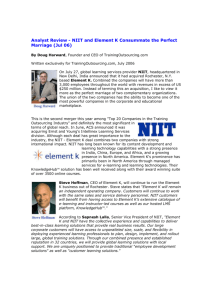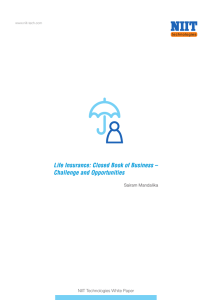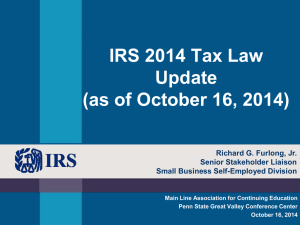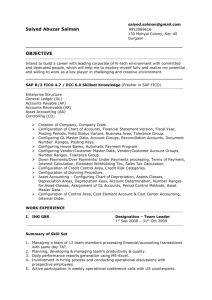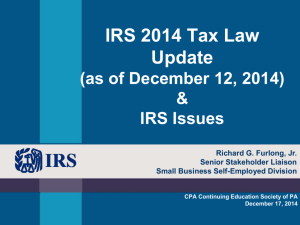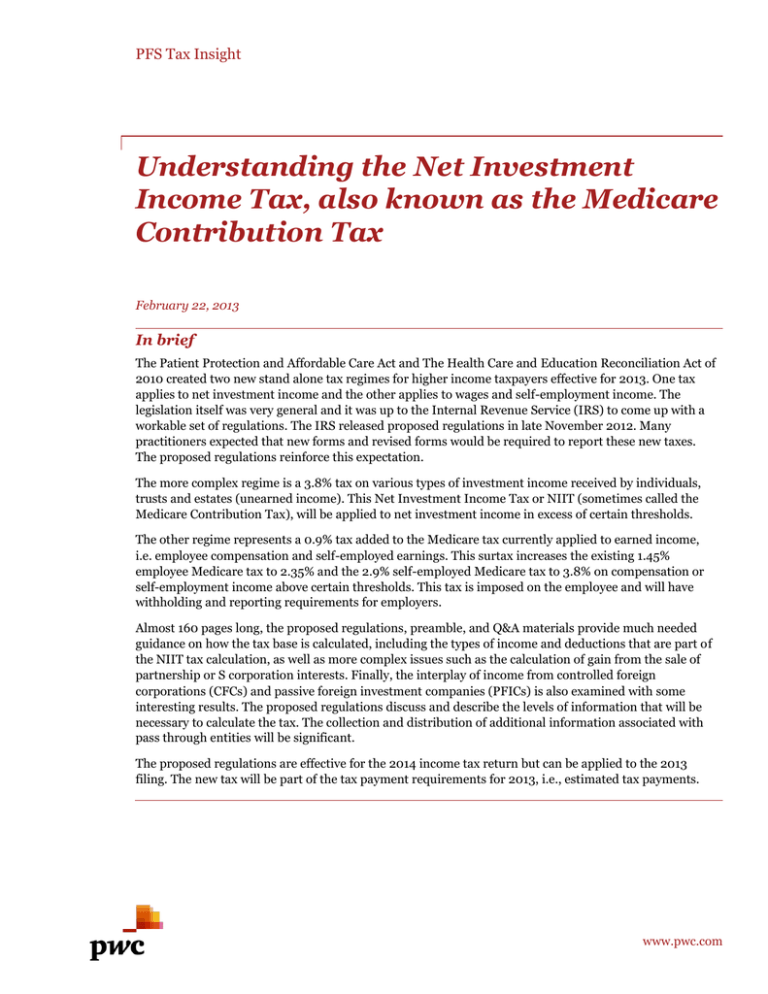
PFS Tax Insight
Understanding the Net Investment
Income Tax, also known as the Medicare
Contribution Tax
February 22, 2013
In brief
The Patient Protection and Affordable Care Act and The Health Care and Education Reconciliation Act of
2010 created two new stand alone tax regimes for higher income taxpayers effective for 2013. One tax
applies to net investment income and the other applies to wages and self-employment income. The
legislation itself was very general and it was up to the Internal Revenue Service (IRS) to come up with a
workable set of regulations. The IRS released proposed regulations in late November 2012. Many
practitioners expected that new forms and revised forms would be required to report these new taxes.
The proposed regulations reinforce this expectation.
The more complex regime is a 3.8% tax on various types of investment income received by individuals,
trusts and estates (unearned income). This Net Investment Income Tax or NIIT (sometimes called the
Medicare Contribution Tax), will be applied to net investment income in excess of certain thresholds.
The other regime represents a 0.9% tax added to the Medicare tax currently applied to earned income,
i.e. employee compensation and self-employed earnings. This surtax increases the existing 1.45%
employee Medicare tax to 2.35% and the 2.9% self-employed Medicare tax to 3.8% on compensation or
self-employment income above certain thresholds. This tax is imposed on the employee and will have
withholding and reporting requirements for employers.
Almost 160 pages long, the proposed regulations, preamble, and Q&A materials provide much needed
guidance on how the tax base is calculated, including the types of income and deductions that are part of
the NIIT tax calculation, as well as more complex issues such as the calculation of gain from the sale of
partnership or S corporation interests. Finally, the interplay of income from controlled foreign
corporations (CFCs) and passive foreign investment companies (PFICs) is also examined with some
interesting results. The proposed regulations discuss and describe the levels of information that will be
necessary to calculate the tax. The collection and distribution of additional information associated with
pass through entities will be significant.
The proposed regulations are effective for the 2014 income tax return but can be applied to the 2013
filing. The new tax will be part of the tax payment requirements for 2013, i.e., estimated tax payments.
www.pwc.com
PFS Tax Insight
In detail
The purpose of this executive
summary is to explain the general
workings of the NIIT including the
categories of income subject to NIIT,
the types of income not subject to the
NIIT, and the deductions available
against NIIT.
Overview
Net investment income is gross
investment income less deductions
allocable to that income. Investment
income comes from three categories.
The first category is traditional
portfolio income such as interest,
dividends, annuity income, royalties,
and certain types of rental activities.
The second category of investment
income includes trade or business
income from 'passive investments' as
well as income from trading in
financial instruments. This category
makes reference to the passive activity
rules. The final category of investment
income is gains from disposition of
property including capital gain from
portfolio investments and capital gain
from sales of 'passive activities'.
Capital gain from the sale of a primary
residence is only subject to NIIT if the
gain on sale exceeds the existing
exclusion.
After combining income from the
three categories (losses from one
category do not reduce income from
another category) certain deductions
are allowed to arrive at 'Net
Investment Income.'
The 3.8% tax then applies to the lesser
of (1) net investment income or (2) the
excess of a taxpayer's modified
adjusted gross income (MAGI) over an
applicable threshold amount. Note
that the threshold level is BEFORE
itemized deductions. Further the NIIT
applies to individuals who might not
be in the maximum income tax
bracket.
2
The threshold amount for single
taxpayers is $200,000 and for
married taxpayers filing jointly is
$250,000. For married individuals
filing separately, the threshold is
$125,000. The threshold for trusts is
$11,950 (the income level at which the
maximum income tax rate begins).
Example — Bill is single ($200,000
NIIT threshold). He has wage income
of $185,000 and interest income of
$25,000. He has no itemized
deductions. His modified adjusted
gross income is $210,000. He is
subject to NIIT on $10,000 — the
lesser of net investment income
($25,000) or income above the
threshold ($10,000).
Example — Mike is single ($200,000
NIIT threshold). His wage income is
$500,000 and he has $35,000 of
interest and dividend income. He has
no itemized deductions. Mike's
modified adjusted gross income is
$535,000. He is subject to NIIT on
$35,000 — the lesser of net
investment income ($35,000) or
income above the threshold
($335,000).
Certain types of income are excluded
from the definition of net investment
income:
earned income — wages and selfemployment income (subject to the
0.9% Medicare supplement tax)
so called active trade or business
income
distributions from qualified
retirement plans or IRAs
interest on municipal bonds
excludable portion of gain on
primary residence sale.
Note that while earned income, active
business income, and retirement plan
distributions are not subject to NIIT
they do increase adjusted gross
income (increasing the likelihood that
the tax will apply).
The active trade or business income
exclusion does not apply to 'income,
gain, or loss on working capital,'
which is characterized as net
investment income. The IRS
regulations make it clear that portfolio
type income passing through
partnerships and S corporations
retains it character as portfolio
income.
The categories of income
The regulations discuss the three
different categories of investment
income in separate sections and state
that losses in one category are not
allowed to offset income or gain in
another category. In particular the
disposition of passive activities and
the release of suspended passive
activity losses is mentioned as a topic
for future guidance. There are some
types of investments that straddle
different categories.
Portfolio income
The proposed regulations simply
repeat the different income types
included in the original legislation.
Greater clarity is provided in the
preamble to the proposed regulations.
Interest and dividend income
includes substitute interest or
dividends, constructive dividends,
distributions from previously taxed
earnings and profits and certain
excess distributions from passive
foreign investment companies
(PFICs). The inclusion of income and
dividends from a foreign entity
(controlled foreign corporations or
passive foreign investment
companies) in net investment income
has special record keeping and
election aspects.
Notional principal contract
income is not considered investment
income unless it is associated with the
pwc
PFS Tax Insight
trading of financial instruments or
commodities. This sets up a
distinction between notional principal
contracts (often part of hedging or
swap strategies) that are entered into
as an investor compared to contracts
entered into by a trader in financial
instruments. The expenses associated
with investor contracts would be a
miscellaneous itemized deduction
rather than a trade or business
expense. Note that the gain from the
disposition of a notional principal
contract is subject to NIIT even for an
investor.
Annuity income includes payments
from an annuity, endowment, or life
insurance contract that is otherwise
included in income under Internal
Revenue Code Section 72. The annuity
exclusion and basis recovery rules
would first be applied to determine
the amount included in income.
Royalty income includes mineral, oil
and gas royalties, and amounts
received for the privilege of using
patents, copyrights, secret processes
and formulas, goodwill, trademarks,
trade brands, franchises, and other
like property.
Rental income is a complex topic that
has the potential to straddle
categories. Rental income which is not
conducted as a regular trade or
business is included in the first
category of portfolio type income.
However, rental income conducted as
a trade or business is part of the
second category of investment income
(where the individual or trust is
subject to the passive activity rules—
see below). The proposed regulations
spend some time discussing the
difference between rental activities
that are not a trade or business and
rental activities that are a trade or
business without providing any
practical examples. The proposed
regulations reference cases and
rulings that guide this determination.
This reference is to a series of court
3
cases and private letter rulings in the
years before the passive activity loss
rules (pre 1987) where the IRS
sometimes took contradictory
positions. The court cases treated
most rental property as a trade or
business for income tax purposes
while the IRS refused to respect that
treatment for estate tax related special
valuation and installment payment.
Rental real estate subject to a triple
net lease would be an example of
rental income that would not be a
trade or business activity.
Income from Passive Foreign
Investment Companies (PFICs) is
investment income but only when
actually distributed according to the
proposed regulations. The current
recognition of income from a
Qualified Electing Fund (QEF) does
not apply for the calculation of Net
Investment Income (absent a special
election). This creates a potential
timing difference for those investors
that have made the QEF election for
regular income tax purposes. This
would result in income being reported
earlier for income tax purposes than
for NIIT purposes. The proposed
regulations create a special NIIT QEF
election so individuals need not
separately track PFIC activity (income
that is reported for regular income tax
purposes compared to income that is
reported for NIIT purposes). This
special NIIT election is made at the
individual level and would apply to all
the individual's PFICs. This means
that pass through entities such as
partnerships and S corporations must
furnish both types of reporting
information to their individual
investors. Similar rules apply to
controlled foreign corporations
(CFCs).
Income from Section 529 Qualified
Tuition Plans not used for education
purposes is not subject to NIIT. This is
specifically addressed in the preamble
to the regulations. However, such
distributions may be subject to a 10%
excise tax (and would increase
adjusted gross income).
Not addressed in the preamble or
regulations is the treatment of income
from currency transactions that are
not associated with a trade or
business, lottery/gambling winnings,
foreign pension plan payments, or
foreign government plan payments.
Trade or business income
The second category of income
includes either trade or business
income from 'passive activities' or
income from the business of trading in
financial instruments or commodities.
This category would include business
income reported on Schedule C,
Schedule E, or Schedule F of an
individual or trust tax return.
Business income would include
businesses organized as sole
proprietors, entities that are treated as
partnerships (such as LLCs) and S
Corporations.
Earnings from pass-through entities
such as partnerships, LLCs, and S
corporations are reported on Schedule
K-1 and are broken into component
parts (aka separately stated items).
Different lines on the Schedule K-1 are
earmarked for business activity
income while others are earmarked
for investment related income. The
Schedule K-1 lines that report interest,
dividends, or other portfolio income
retain their character for NIIT (as
portfolio income discussed above).
The Schedule K-1 lines related to trade
or business activity also retain their
character.
Business income from a 'passive
activity' is subject to NIIT. The
determination of whether a business
activity is 'passive' or 'active' (more
correctly referred to as 'material
participation') requires a journey into
the complex passive activity loss
regulations and is made at the
individual or trust level. Thus, pass
through entities will be under more
pwc
PFS Tax Insight
pressure to provide details about
business operations so the individual
or trust can correctly determine the
treatment of income from that trade
or business. This level of detail will be
even more important for layered or
tiered structures with multiple
business activities.
The new importance of 'passive
activity' will turn the entire passive
versus material participation
categorization upside down.
Historically, 'passive' activity
treatment was a desirable result for
income producing businesses. No
longer is that necessarily the case.
Taxpayers will now be seeking ways to
meet the material participation
standards and have the activity
classified as a material participation
trade or business (not subject to
NIIT).
The passive activity regulations have
extensive rules and definitions that
will be critical in determining NIIT
application. The passive activity
regulations require that the taxpayer
group 'undertakings' into activities
based on a series of guidelines. The
activity is then tested for material
participation. There are seven
different material participation tests.
The most common test is a 500 hour
test (does the individual spend 500 or
more hours at the activity). The
grouping of undertakings and
activities is a critical part of meeting
the material participation standard.
Special rules apply to real estate
professionals and real estate rented to
a related material participation
business (although the proposed
regulations suggest that real estate
rented to a related material
participation business may not be a
trade or business activity). A detailed
discussion of the material
participation rules is beyond the scope
of this executive summary. It is
important to note that activities may
be passive some years and not passive
in other years. The determination is
4
made at the individual or trust level at
the end of the year based on the level
of participation during the year.
Normally, activity grouping cannot be
changed without IRS permission
(absent a change in facts and
circumstances). However, the IRS
recognizes that the NIIT casts new
importance on correctly grouping
undertakings and activities. The
proposed regulations permit a 'fresh
start' regrouping for NIIT calculation
purposes beginning in 2014 (or 2013 if
the NIIT applies).
Business income from activities that
are classified as 'material
participation' are NOT subject to NIIT
(although portfolio income from the
business will be subject to NIIT).
A practical problem associated with
trade or business activity is the need
to make estimated tax payments of
NIIT during the year. Taxpayer's will
be forced to make a tentative
determination about 'passive
activities' for estimated tax purposes
even though the determination cannot
be made until the year is over.
Taxpayer's may deliberately over pay
NIIT estimated amounts to avoid
penalty (for those who are using
current year tax as the target rather
than 110% of prior year tax).
Trust owners of business
activities have a special issue to deal
with in determining passive activity
status. Generally, the activities of the
trustee are examined to determine
passive status, but there is a court case
that suggests that agents, employees,
and beneficiary activity may also be
considered.
Business income from trading in
financial instruments or
commodities is not subject to the
passive activity rules. Instead it is all
subject to NIIT as a specific sub-set of
trade or business activity. This type of
activity has the potential to straddle
categories.
The determination of whether the
entity is engaged in 'the business of
trading in financial instruments or
commodities' is made at the entity
level. The determination of 'trader'
status and any resulting elections are
important determinations that are
beyond the scope of this executive
summary. The proposed regulations
have an extensive description of the
income and deductions that are
usually associated with trading in
financial instruments or commodities.
Gains from disposition of property
The final category of income subject to
NIIT is gain from the disposition of
property (other than property held in
a trade or business). This would
include gain on the sale of stocks,
bonds, mutual funds, and second
residences. Sales of rental property
are subject to NIIT if the rental
activity was a passive activity or not
part of a trade or business. Taxable
gain from the sale of a primary
residence (after applicable gain
exclusions) is also subject to NIIT.
Distributions from partnerships or S
corporations in excess of basis are
subject to NIIT. Finally, dispositions
of notional principal contracts fall into
this category.
Gain from the disposition of an
interest in a partnership or S
corporation presents a particular
problem because the NIIT does not
apply to gains associated with a
material participation trade or
business. The proposed regulations
recognize this distinction and require
that the sale of an interest in a
partnership or S corporation be
treated as if the owner had sold all the
assets of the business (a look through
test). Each asset of the business must
be examined separately to determine
if it was used in the material
participation trade or business. The
sale of assets used in the business
activity where the taxpayer materially
participates would be exempt from
pwc
PFS Tax Insight
NIIT. Assets owned by the business
but not used in the trade or business
activity would be subject to NIIT.
Obviously the categorization of assets
within the partnership and
determining which assets are business
assets and which assets are unrelated
to the business will be an area of
concern. The proposed regulations
contain an extensive discussion of the
complex determinations and
calculations involved when a business
is sold. A discussion of this look
through determination is beyond the
scope of this executive summary.
Mark-to-market gains associated with
swaps (notional principal contracts)
are not treated as a disposition of
property. Such gains would not be
subject to NIIT for investors.
However, mark-to-market gains
associated with trader activities would
be subject to NIIT as part of trade or
business income.
Not addressed in the proposed
regulations is how to treat current
year gain from prior year installment
sales. The regulations discuss
installment sales of partnership and S
corporation interests but not other
types of installment sales (such as real
estate).
Multiple category income
While the legislation and proposed
regulations neatly organize income
into three categories, there are several
types of income that straddle the
categories. Ongoing rental activities
can fall into either category one
(portfolio income) or category two
(trade or business) while the sale of
the property will be captured in
category three (gains from disposition
of property). The discussion of rental
income that is not a trade or business
in the proposed regulations is likely to
create differences in interpretation.
Investment and trader
partnerships will have to be
5
especially careful about income and
deduction categorization.
The IRS has specifically requested
comments on the disposition of a
passive activity. Passive activity
disposition will often 'release'
suspended trade or business losses
(category two income) as well as
capital gain resulting from
depreciation recapture (category three
income).
Deductions from investment
income
The proposed regulations provide that
the following deductions may be used
to offset investment income:
investment interest expense
investment expenses
may be easier to calculate. Note that
investment interest expense is not
subject to the itemized deduction
phase-out.
Finally, the proposed regulations
comment that any reasonable method
can be used to apportion state and
local income tax against investment
income. Collectively, these deductions
cannot reduce net investment income
below zero and cannot be carried over
for NIIT purposes. Normal income tax
rules associated with investment
interest expense carryover will apply
for NIIT purposes.
Net operating losses may not be used
to offset investment income.
Credits
penalties for early withdrawal of
savings
Neither the legislation nor the
proposed regulations discuss credits
against the NIIT. This would be of
particular interest to individuals and
trusts with foreign source investment
income.
allocable state and local income
taxes.
Individuals and trusts – Special
rules
expenses attributable to rents and
royalties
It should be noted that these
deductions are only allowed to the
extent that they are deductible when
calculating ordinary income for
regular income tax purposes. This
means that the investment interest
limits would be applied to determine
the deductible amount of investment
interest. Other investment related
expenses (investment management
fees and expenses for the production
of income) would be subject to the 2%
floor on miscellaneous itemized
deductions before being used against
investment income.
The phase-out of itemized deductions
must be apportioned across all
deductions subject to phase-out
before they can be applied against
investment income. This is a
departure from the 'with and without'
method often used with tax
calculations. The pro-rata method
Only individuals, trusts, and estates
are subject to the NIIT. However,
there are some special individual
situations that are addressed in the
proposed regulations. Likewise there
are a number of special rules that
apply to trusts. Trust owners of
partnerships and S corporations must
pay special attention to how the
passive activity loss rules apply to
them.
Individuals
NIIT applies to US citizens or
residents. The tax does not apply to
non-resident aliens and residents of
certain US territories. A unique
situation arises when a US resident
has a non-resident alien spouse. The
proposed regulations note that the
non-resident alien spouse is not
subject to NIIT unless the couple
makes an election to subject the nonresident alien spouse to US income
pwc
PFS Tax Insight
tax. This election is then effective for
NIIT purposes as well.
The NIIT threshold amounts for
individuals are $250,000 for a joint
return, $200,000 for a single
taxpayer, and $125,000 for a married
couple filing separately. The threshold
amounts will be prorated for an
individual with a short tax year due to
an accounting period change.
However, the threshold amount is
NOT prorated for an individual who
dies during the year. Note that the
maximum income tax rates begin at
different dollar thresholds and the
threshold for income tax rates is
taxable income and not modified
adjusted gross income.
The Q&A provided by the IRS points
out that a child's investment income
included on the parents return, the socalled 'kiddie tax' election, will be
subject to the NIIT.
Estates and trusts
The taxation of trusts and estates
depends on the type of trust and
whether the trust income is
distributed or retained by the trust. To
the extent the trust or estate retains
the income it will be subject to NIIT at
the trust level. Income distributed to
beneficiaries may be subject to NIIT
on the beneficiary's personal tax
return. The NIIT threshold for income
retained by the trust or estate is
$11,950 (the income level at which the
maximum tax bracket begins). The
threshold amount is reduced if the
trust or estate has a short taxable year
resulting from the formation or
termination of the trust or estate.
Trusts generally maintain two parallel
sets of books. One set of records
represents general accounting rules
that separate receipts into principal or
income. This distinction is important
for the beneficiaries of the trust since
some beneficiaries may only be
entitled to income while others are
entitled to principal. This set of
6
records is based on state law
concerning trust operations (so called
principal and income statutes). The
second set of records is for income tax
purposes and determines whether the
trust pays income tax on the receipts
or whether it is passed to the
beneficiary and subject to tax on the
beneficiary's personal return.
The NIIT creates a third set of records
and requires that trusts now track Net
Investment Income and determine if
Net Investment Income has been
retained by the trust or distributed to
the beneficiary. If Net Investment
Income is distributed to the
beneficiary then the trustee must
provide the beneficiary with regular
income tax data and NIIT data.
The NIIT applies to pooled income
funds, cemetery perpetual care funds,
qualified funeral trusts, and certain
Alaska Native settlement trusts. The
IRS has requested comments about
the application of NIIT to these
entities.
Special trust and estate rules
There are a number of special types of
trusts with their own set of rules
A grantor trust is a disregarded
entity for income tax purposes. Trust
income is reported directly on the
'grantor's' personal tax return. The
proposed regulations note that the
NIIT applies only at the individual
income tax return of the grantor. The
trust is not subject to NIIT (since it is
ignored for tax purposes).
A bankruptcy estate is simply a
special way to calculate income tax for
those in bankruptcy. A bankruptcy
estate is treated in the same manner
as a married person filing separately.
The proposed regulations note that
the NIIT threshold is $125,000 for a
bankruptcy estate.
An Electing Small Business Trust
(ESBT) is a trust that owns shares in
an S corporation. Special rules apply
to calculate income tax associated
with S corporation income. Regular
trust tax rules apply to income from
other assets (if any). In effect the trust
is bifurcated into two 'portions' for
regular income tax purposes with
different rules applied to each portion.
The proposed NIIT regulations
require that the two portions be
aggregated in determining the
threshold for NIIT purposes.
A charitable remainder trust pays
income to a beneficiary for a period of
time and then the assets are
transferred to charity. The trust itself
pays no income tax. Instead the
beneficiary is subject to income tax on
distributions based on a complex tier
system that tracks both current year
income as well as prior year
undistributed income and gain. The
proposed regulations add a new NIIT
recordkeeping requirement on the
trust. The charitable remainder trust
must also track income and gain
earned after 12/31/12 and report
distributions subject to NIIT to the
beneficiary each year. The proposed
regulations make it clear that
accumulated income and gain as of
12/31/2012 will not be subject to NIIT
when received by the beneficiary.
Unfortunately, pre-2013 accumulated
income and gain (not subject to NIIT)
are distributed only after post-2012
income and gain (subject to NIIT) has
been exhausted.
Foreign trusts and estates are not
subject to NIIT or any US income tax.
However, the beneficiary of a foreign
trust or estate has a special calculation
that is applied to distributions for
regular income tax purposes. The
proposed regulations specifically do
not address the application of NIIT to
a US beneficiary of a foreign trust or
estate. The IRS has requested
comments on the application of NIIT
to foreign trusts and estates with US
beneficiaries. Likewise, the IRS has
requested comments on whether
foreign pension funds that are treated
pwc
PFS Tax Insight
as trusts for US purposes should also
be excluded from NIIT.
Earned income Medicare surtax
Currently the Medicare tax is 2.9% of
all earned income. Employees pay
1.45% of this tax and employers pay
1.45% of the tax. Self-employed
individuals pay the entire 2.9% but
receive an income tax deduction for
1/2 of the tax.
Beginning in 2013 the employee
portion of this tax will be increased by
0.9% for high income taxpayers. The
surtax applies to earned income over
$200,000 for single individuals and
$250,000 for married couples filing a
joint tax return. Note that the
thresholds only apply to earned
income and not modified adjusted
gross income. The surtax also applies
to self-employment earnings. The
deduction for self-employment taxes
is not increased by the .9% surtax.
Payroll providers must be alert for
wages over the thresholds and begin
to collect the surtax. Employees with
multiple jobs and working couples
create additional complexity. The
proposed regulations did not deal with
the Earned Income Medicare Surtax.
The takeaway
The Net Investment Income Tax is a
complex stand alone tax. The
legislation did not provide definitions
or terminology. The proposed
regulations specifically point out areas
where the NIIT terminology is likely
to vary from traditional income tax
terminology.
Even though the proposed regulations
mark a significant step, the complexity
of the topics and the need to make
subtle distinctions for record keeping
and compliance will foster challenges
for taxpayers, tax practitioners, and
the IRS for years to come.
Let’s talk
For a deeper discussion of how this issue might affect your business, please contact:
Personal Financial Services
Brittney Saks, Partner
US Personal Financial Services Leader
(312) 298-2450
brittney.b.saks@us.pwc.com
William Zatorski, Partner
(973) 236-4943
william.zatorski@us.pwc.com
Rich Wagman, Partner
(617) 530-7003
richard.s.wagman@us.pwc.com
Ashley Scott, Atlanta
(678) 419-1763
ashley.p.scott@us.pwc.com
David Zimmerman, Boston
(617) 530-5353
david.w.zimmerman@us.pwc.com
William Callahan, Chicago
(312) 298-4162
william.b.callahan@us.pwc.com
Mark Stevens, Cleveland
(216) 875-3512
mark.r.stevens@us.pwc.com
Michael Petrecca, Columbus
(614) 225-8853
michael.a.petrecca@us.pwc.com
Gerald Louviere, Dallas
(214) 756-1732
gerald.louviere@us.pwc.com
David VanEgmond, Detroit
(313) 394-6531
david.a.vanegmond@us.pwc.com
Mark Yarbrough, Greensboro
(336) 665-3449
mark.d.yarbrough@us.pwc.com
Mark Borden, Houston
(713) 356-5645
mark.t.borden@us.pwc.com
Jeff Saccacio, Los Angeles
(213) 217-3227
jeff.j.saccacio@us.pwc.com
Robert Biaggio, Minneapolis
(612) 596-4747
robert.biaggio@us.pwc.com
Victoria Meyer, New York
(646) 471-5030
victoria.meyer@us.pwc.com
Martin Janowiecki, Philadelphia
(267) 330-1588
marty.janowiecki@us.pwc.com
Jonathan Malan, San Francisco
(415) 498-6152
jonathan.f.malan@us.pwc.com
Bradley Crowder, Washington DC
(703) 918-3757
bradley.e.crowder@us.pwc.com
Bill Fleming, Managing Director
(860) 241-7044
william.r.fleming@us.pwc.com
Private Company Services
7
© 2013 PricewaterhouseCoopers LLP. All rights reserved. In this document, PwC refers to PricewaterhouseCoopers (a Delaware limited liability partnership), which
is a member firm of PricewaterhouseCoopers International Limited, each member firm of which is a separate legal entity.
SOLICITATION
This content is for general information purposes only, and should not be used as a substitute for consultation with professional advisors.
pwc

